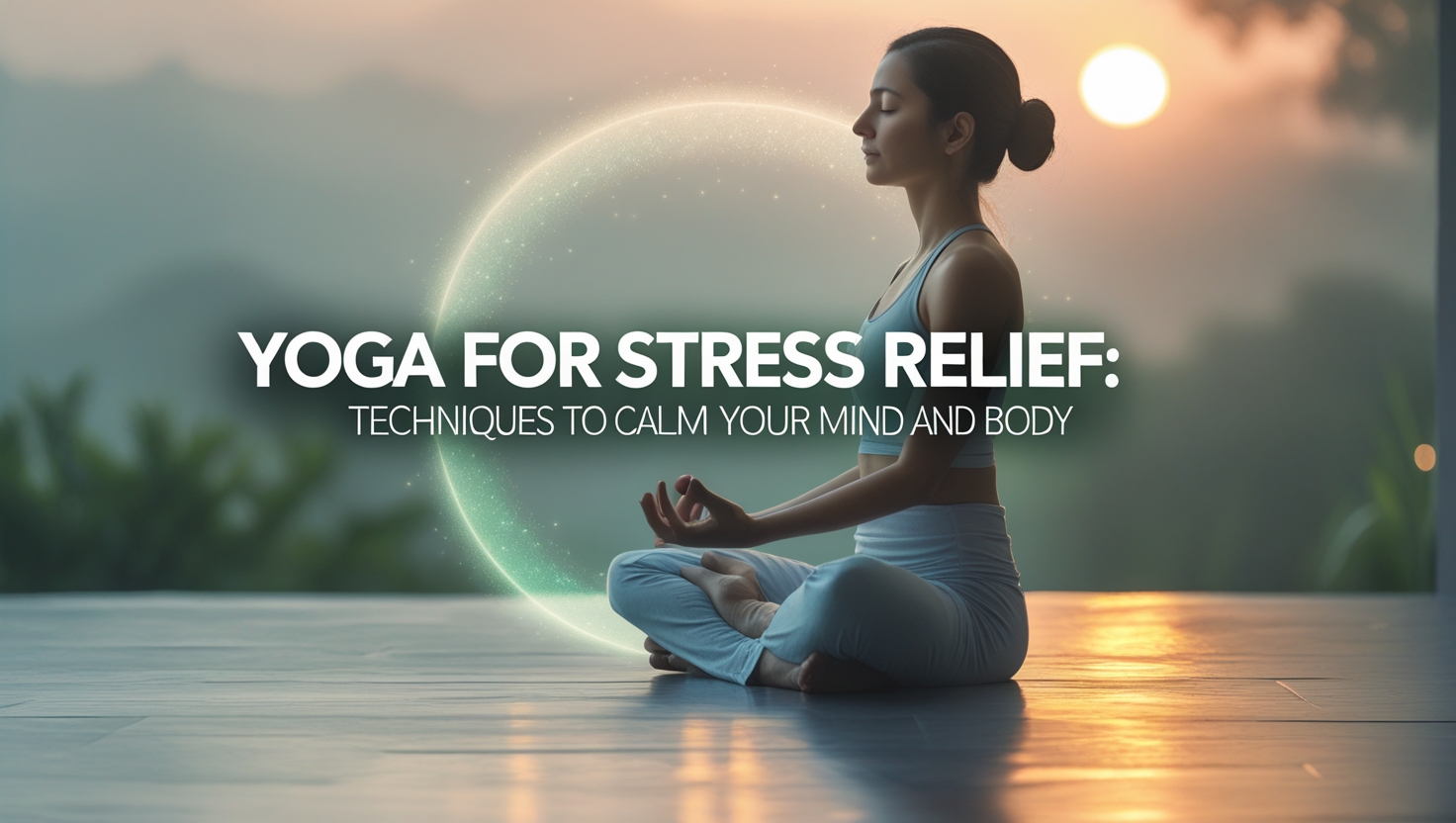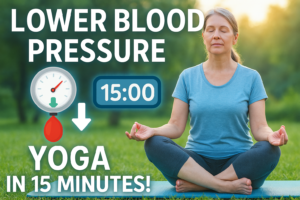Stress is an inevitable part of modern life. From demanding work schedules to personal challenges, many of us find ourselves overwhelmed by daily pressures. Incorporating yoga for stress relief into your routine offers a holistic, natural approach to managing stress. This comprehensive guide explores proven stress reduction yoga techniques that not only calm the mind but also nurture the body, allowing you to regain balance and inner peace.
Introduction: Why Yoga is Essential for Stress Relief
Modern society bombards us with information, responsibilities, and constant stimuli, leading to heightened stress levels that can negatively impact our physical and mental well-being. Yoga for stress relief provides a sanctuary—a space to disconnect from the chaos and reconnect with your inner self. By focusing on mindful movement, controlled breathing, and meditation, yoga helps reduce stress hormones, lower blood pressure, and promote overall relaxation.
The benefits of stress relief yoga extend beyond just feeling calmer. Regular practice can lead to improved sleep, enhanced concentration, and even better immune function. Whether you’re new to yoga or a seasoned practitioner, this guide is designed to offer practical techniques that integrate easily into your daily routine, helping you combat stress and live a more centered, fulfilling life.
The Science Behind Yoga for Stress Relief
How Stress Affects the Body
Stress triggers the body’s “fight or flight” response, releasing hormones such as cortisol and adrenaline. While these hormones are useful in short bursts, chronic stress keeps your body in a constant state of alert, leading to issues like anxiety, insomnia, digestive problems, and even cardiovascular disease.
The Role of Yoga in Stress Reduction
Yoga works by counteracting the stress response through:
- Mindful Movement: Physical postures (asanas) stretch and relax muscles, reducing tension.
- Breath Control: Pranayama, or controlled breathing techniques, helps regulate the nervous system and reduce anxiety.
- Meditation: Focusing the mind on the present moment calms mental chatter and encourages a state of deep relaxation.
Research has shown that regular yoga practice can decrease cortisol levels, lower heart rate, and promote feelings of well-being. These physiological benefits underscore why stress reduction yoga is an effective method for managing stress.
Benefits of Yoga for Stress Relief
1. Reducing Cortisol Levels
Cortisol, known as the stress hormone, can wreak havoc on the body when levels remain elevated. Yoga techniques that emphasize deep breathing and mindful movement help reduce cortisol, creating a sense of calm and well-being.
2. Enhancing Mental Clarity
When stress overwhelms the mind, clarity and focus can be hard to find. Yoga for stress relief centers the mind through meditation and mindfulness, allowing you to detach from stressful thoughts and focus on the present.
3. Improving Sleep Quality
Chronic stress often leads to sleep disturbances. Incorporating yoga for stress relief into your evening routine can help relax the body and mind, promoting better sleep quality and helping you wake up refreshed.
4. Boosting Immune Function
High stress levels can weaken the immune system. Regular yoga practice not only reduces stress but also improves blood circulation and enhances immune function, protecting your body against illness.
5. Promoting Overall Physical Relaxation
Gentle stretching and restorative poses relieve muscle tension and improve flexibility. By alleviating physical symptoms of stress, yoga helps create a harmonious balance between the mind and body.
Key Yoga Techniques for Stress Relief
In this section, we’ll explore a series of techniques designed to ease stress. Each technique is crafted to calm your mind, relax your body, and help you build a sustainable, stress-free lifestyle.
1. Breathing Exercises (Pranayama)

Breath is the bridge between the body and mind. Controlled breathing techniques are foundational in yoga for stress relief. They help slow the heart rate, lower blood pressure, and induce a state of calm.
Alternate Nostril Breathing (Nadi Shodhana)
How to Do It:
- Sit comfortably with your spine straight.
- Close your right nostril with your right thumb.
- Inhale slowly through your left nostril.
- Close your left nostril with your ring finger, then exhale slowly through your right nostril.
- Inhale through your right nostril, close it, and exhale through your left.
- Continue this alternate pattern for 5-10 minutes.
Benefits:
- Balances the nervous system.
- Calms the mind and reduces anxiety.
- Promotes mental clarity and focus.
Deep Diaphragmatic Breathing
How to Do It:
- Lie on your back or sit comfortably.
- Place one hand on your chest and the other on your belly.
- Inhale deeply through your nose, letting your belly rise while keeping your chest relatively still.
- Exhale slowly through your mouth, feeling your belly fall.
- Practice for 5-10 minutes, focusing on the movement of your breath.
Benefits:
- Enhances oxygen exchange.
- Reduces muscle tension.
- Promotes relaxation and stress relief.
2. Gentle Yoga Poses (Asanas) for Stress Relief

Certain yoga poses are especially effective at releasing tension and promoting relaxation. These stress reduction yoga poses can be incorporated into your daily practice to soothe both body and mind.
Child’s Pose (Balasana)

How to Do It:
- Begin by kneeling on the floor with your big toes touching and your knees spread apart.
- Sit back onto your heels and lower your torso forward, resting your forehead on the mat.
- Extend your arms forward or rest them alongside your body.
- Hold the pose for 1-2 minutes while breathing deeply.
Benefits:
- Gently stretches the back and hips.
- Creates a sense of security and calm.
- Helps release tension in the lower back.
Forward Bend (Uttanasana)

How to Do It:
- Stand with your feet hip-width apart.
- Inhale deeply and lift your arms overhead.
- Exhale as you hinge at the hips, folding forward while keeping a slight bend in your knees.
- Let your head hang heavy and relax your neck.
- Hold for 1-2 minutes, focusing on slow, deep breaths.
Benefits:
- Relieves tension in the spine and neck.
- Calms the mind by releasing stored stress.
- Stimulates blood flow to the brain.
Legs-Up-The-Wall Pose (Viparita Karani)

How to Do It:
- Sit next to a wall and lie down on your back.
- Extend your legs up against the wall, keeping them straight.
- Relax your arms at your sides and close your eyes.
- Stay in this position for 5-10 minutes, focusing on your breath.
Benefits:
- Reduces stress and anxiety.
- Promotes circulation and relieves tired legs.
- Helps calm the nervous system.
Corpse Pose (Savasana)

How to Do It:
- Lie flat on your back on a comfortable surface.
- Let your arms and legs relax naturally.
- Close your eyes and allow your body to completely unwind.
- Stay in the pose for 5-10 minutes, letting go of all tension.
Benefits:
- Induces deep relaxation.
- Allows the body to absorb the benefits of the practice.
- Calms the mind and reduces overall stress.
3. Meditation Techniques
Meditation is an essential component of yoga for stress relief. It helps quiet the mind, reduce anxiety, and create a deeper connection with yourself.
Guided Meditation
How to Do It:
- Find a comfortable seated position.
- Use a guided meditation app or recording designed for stress relief.
- Follow the prompts, allowing your mind to focus on relaxing imagery or calming words.
- Continue for 10-15 minutes, gradually letting go of external distractions.
Benefits:
- Provides structure and support for beginners.
- Reduces stress by guiding your focus away from anxious thoughts.
- Enhances mindfulness and self-awareness.
Mindfulness Meditation
How to Do It:
- Sit comfortably with your eyes closed.
- Focus on your breath or a single point of focus, such as the sensation of your feet touching the ground.
- If thoughts arise, acknowledge them without judgment and gently return your focus to your breath.
- Practice for 10-20 minutes.
Benefits:
- Increases mental clarity and focus.
- Reduces reactive responses to stress.
- Cultivates a deep sense of presence and inner peace.
Body Scan Meditation
How to Do It:
- Lie down in a comfortable position.
- Close your eyes and focus on each part of your body sequentially, from your toes to your head.
- Notice any sensations, tension, or discomfort without trying to change them.
- Spend 1-2 minutes on each body part, gradually moving upward.
- This practice typically lasts 15-20 minutes.
Benefits:
- Enhances awareness of physical sensations.
- Identifies areas of tension for targeted relaxation.
- Promotes a holistic sense of relaxation and stress relief.
Creating a Daily Routine for Stress Relief
Consistency is key when it comes to stress reduction yoga. By integrating these techniques into your daily routine, you can experience long-term benefits that extend beyond the yoga mat.
Morning Routine
Starting your day with a short yoga session can set a positive tone for the day ahead. Consider beginning with:
- 5-10 minutes of deep diaphragmatic breathing.
- A series of gentle poses such as Forward Bend or Child’s Pose.
- 5 minutes of mindfulness meditation to cultivate focus and calm.
Midday Reset
A quick midday session can help you manage stress as it accumulates throughout the day. Options include:
- Alternate Nostril Breathing for 5 minutes to rebalance your energy.
- A short Body Scan Meditation to release tension built up during the day.
- Light stretching with poses like Legs-Up-The-Wall to re-energize.
Evening Wind-Down
End your day with a calming yoga routine to promote better sleep and relaxation:
- Begin with gentle stretching and deep breathing exercises.
- Transition into a longer Corpse Pose or guided meditation for 10-15 minutes.
- Focus on releasing any stress or tension from the day, preparing your body for restorative sleep.
Incorporating Yoga into a Stress Management Lifestyle
Beyond daily yoga sessions, adopting a holistic approach to stress management can amplify the benefits of your practice. Here are some additional tips:
1. Create a Calm Environment
Set up a dedicated space in your home where you can practice yoga and meditate without distractions. This space should be quiet, clutter-free, and conducive to relaxation.
2. Stay Consistent
Consistency builds resilience. Even on busy days, try to incorporate a few minutes of yoga or meditation. Over time, these small practices accumulate to create significant, long-lasting benefits.
3. Combine with Other Healthy Habits
Incorporate stress-relieving activities into your daily life, such as:
- Regular exercise
- A balanced diet
- Sufficient sleep
- Time spent in nature
These habits complement your yoga for stress relief practice, creating a comprehensive approach to well-being.
4. Seek Community Support
Join a local yoga class or online community dedicated to stress relief. Sharing your experiences with others who understand the challenges of stress can offer motivation and new insights into your practice.
5. Keep a Journal
Document your progress, noting how you feel before and after each session. Journaling can help track improvements in your stress levels and overall mental health, while also providing a space for reflection and gratitude.
Real-Life Success Stories
Many individuals have transformed their lives by embracing yoga for stress relief. For example, Emma, a busy marketing professional, began incorporating a 15-minute yoga session into her morning routine. Over a few months, she noticed a significant decrease in her anxiety levels and an increase in her overall energy. Similarly, David, a software engineer, used a combination of deep breathing exercises and mindfulness meditation during stressful periods at work, finding that these practices improved his concentration and reduced his stress-related headaches.
These stories are a testament to the power of integrating yoga into your daily life. The transformative effects of stress reduction yoga can lead to a more balanced, focused, and joyful existence.
Frequently Asked Questions (FAQs)
1. How soon can I expect to see the benefits of yoga for stress relief?
Many practitioners report feeling calmer and more centered after just a few sessions. However, the full benefits of yoga for stress relief accumulate over time with consistent practice. It may take several weeks to notice significant changes, especially if you’re integrating multiple techniques like pranayama, asanas, and meditation.
2. Can I practice these techniques if I’m new to yoga?
Absolutely. The techniques outlined in this guide are designed to be accessible for beginners. Start with shorter sessions and simple poses, gradually building up to longer, more comprehensive practices as you become more comfortable.
3. How often should I practice yoga for stress relief?
For optimal benefits, aim for at least 20-30 minutes of stress-relief yoga daily. Even short sessions spread throughout the day can help manage stress levels effectively. Consistency is key.
4. Is yoga for stress relief effective if I have no previous yoga experience?
Yes. Yoga is a highly adaptable practice. Beginners can modify poses and techniques to suit their needs. Many yoga instructors and online resources are available to help guide you as you begin your journey toward stress relief.
5. What should I do if a pose or technique feels uncomfortable?
Always listen to your body. If a pose causes discomfort or pain, modify it or skip it altogether. It may be beneficial to consult a yoga instructor who can provide personalized adjustments and ensure that your practice remains safe and effective.
Conclusion: Embrace Yoga to Calm Your Mind and Body
Incorporating yoga for stress relief into your daily routine is a transformative practice that addresses both the physical and emotional toll of modern life. By combining mindful breathing, gentle stretches, and meditation techniques, you can effectively reduce stress, enhance mental clarity, and nurture overall well-being.
Whether you’re dealing with the challenges of a high-pressure job, juggling personal responsibilities, or simply seeking a moment of peace, these stress reduction yoga techniques offer practical, accessible solutions to help you regain balance and inner calm. Embrace the journey of yoga as a lifelong tool for managing stress, cultivating mindfulness, and creating a more harmonious life.
Remember, every deep breath and mindful movement brings you one step closer to a calmer, more centered state of being. Start today—set aside a few minutes for your practice, create a space for relaxation, and allow the healing power of yoga to transform your life.
Your journey to stress relief begins with a single mindful breath. Let yoga be the path that guides you to a state of inner peace and sustained well-being, empowering you to face each day with clarity, resilience, and a calm mind.















Add comment